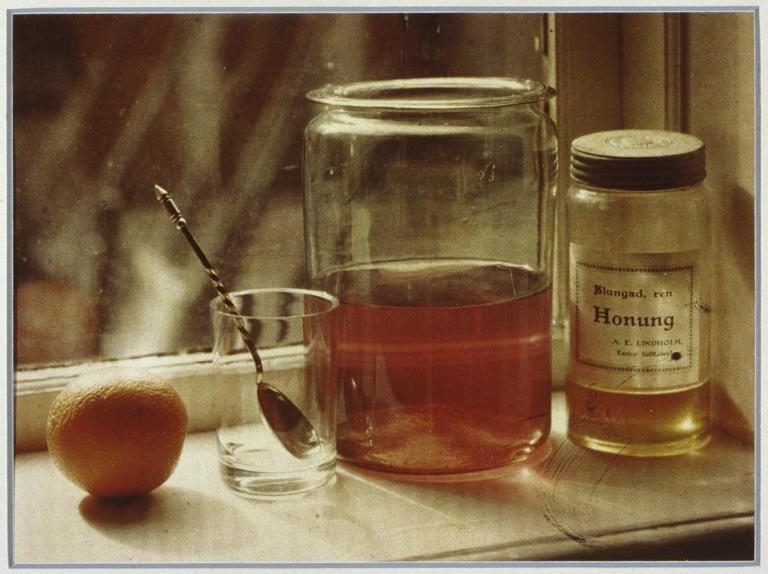 December 17: Our domestic interiors are a much photographed subject, and photography has even changed the way we eat.
December 17: Our domestic interiors are a much photographed subject, and photography has even changed the way we eat.
Cookbooks sell like hotcakes it’s true, and photographing your meals and sharing them on instant social media is a mass phenomenon. Restaurants take it for granted that their dishes will be Instagrammed, with the understanding that it will be instant free advertising. Photographing food has never been so popular, particularly at this time of year!

We would not be surprised to find this image in our social media feed and we might ‘Like’ its sensitive handling of light, its subtle colours, and the incidental details of the gold-rimmed cup, the art nouveau designs embossed on the spoon and that exquisite lace tablecloth. The atmosphere is of restrained but expensive luxury, but…
…the photograph is 110 years old!
Knowing that prompts an amazed second look, to marvel at the freshness and richness of the colour, but also to grasp a fuller experience of what fin-de-siècle life might have been like! The digital colouring of vintage monochrome photographs has, regrettably in many cases, become a trend, but these Autochromes are not ‘coloured’ black-and-white prints, and they open up a whole gamut of sensation missing from pictures from the 1800s. The warm glow of that egg yolk, just like the one you ate this morning, transmits us across a century.

 Wladimir Schohin, born in Helsinki on this date (†1934), was a merchant comfortable with luxury and an avid amateur photographer. He, and his wife Nadezhda Schohin, also a photographer, were enthusiastic members, and he on the committee, of the Swedish photographic association and of the Amatörfotografklubben i Helsingfors (Amateur Club of Helsinki), better known as AFK, established in 1889. There his bromoil, carbon and gum prints were the object of admiration and appreciation by other photo enthusiasts, and his works rewarded in competitions and photo exhibitions. Unfortunately Nadezhda’s photographs have not survived, though perhaps, as is often the case, they have been attributed to her husband.
Wladimir Schohin, born in Helsinki on this date (†1934), was a merchant comfortable with luxury and an avid amateur photographer. He, and his wife Nadezhda Schohin, also a photographer, were enthusiastic members, and he on the committee, of the Swedish photographic association and of the Amatörfotografklubben i Helsingfors (Amateur Club of Helsinki), better known as AFK, established in 1889. There his bromoil, carbon and gum prints were the object of admiration and appreciation by other photo enthusiasts, and his works rewarded in competitions and photo exhibitions. Unfortunately Nadezhda’s photographs have not survived, though perhaps, as is often the case, they have been attributed to her husband.


It happens that today’s date also marks the patenting in 1903 of the Lumière brothers‘, Auguste (1862–1954) and Louis (1864–1948), Autochrome, the first practical method for photography in colour which became a worldwide success after their launch on the market in summer 1907.
Naturally Schohin was excited by the advent of the first commercially available colour process and could afford to buy the expensive transparency material.

By August 1907 the photographer Daniel Nyblin (1856—1923) brought the first shipment to Finland and in early September the AFK was able to publicly display the first Autochromes at the Ateneum, exposing colour pictures to an enthusiastic audience of 3,000;
The art season of the year was opened today an interesting an laudable way by Fotografiamatörklubben i Helsingfors with an exhibition held in the exhibition hall of Ateneum. The [Autochromes were the] novelty among all the beauty offered by the exhibition.
(Hufvudstadsbladet, 1 September 1907)
Some were by Nikolai Leibowitsch (1869-1932) and engineer Walter Jakobsson (1882-1957), as well as press photographer and police reporter Harald Rosenberg (1883–1931) who had grabbed the first new glass plates. He found that photographing people was difficult because of the slow speed of the material, though it could be used in an ordinary camera. The most significant limitation of Autochrome technology was the need for aids for viewing images since they were transparencies and could not be printed.

It was Wladimir Schohinista who was to become the most successful and most famous Swedish “Autochromer”, and continued to take them into the 1920s. Schohin’s are of high quality even by international comparison.


Only about 350 Autochromes survive in Finland; they deteriorate with prolonged exposure to sunlight or to the powerful lamp required to project them. Most are housed in The Finnish Museum of Photography.




How beautiful the colors are! And how we try to mimic them with filters today. I find your posts very inspirational. Thank you for sharing them.
LikeLiked by 1 person